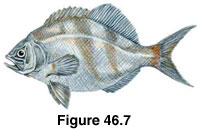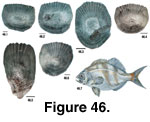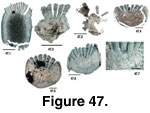 Description
Description
Rhacochilus vacca
(Pile Perch)
(Other common names: Silver Perch, Forktail Perch, Porgy)
Figure 46.7
 Description
DescriptionLength: 44 cm.
Mouth: small, slightly pointed upward, terminal; upper jaw and snout are the same length; lower lip attached to lower jaw by a frenum; teeth are fine.
Body: short and compressed; lateral line flatter than dorsal profile; dorsal fin with low spinous portion with front end of the soft-rayed portion much higher; deeply forked tail; thick, drooping folds around the mouth.
Color: silvery on sides and belly with darky grey or brown above; dark blotches on back and sides, juveniles have vertical bars; dusky fins; sometimes there is a dark spot below the eye.
Depth: shallow waters to 46 m; retreat to deeper waters in winter months.
Habitat: rocky shoreline areas around pilings; prefers complex substrate; schooling species.
Season: mate in winter, October-December with birth in June-October depending on geographical location (in BC in August [Hart, 1973]).
Diet: crustaceans, polychaetes, and mollusks.
Predators: not determined.
Distribution: central Baja, California to southeast Alaska.
 Scale Description
Scale Description Relative Scale Size: moderate to large.
Position of Scales on Body: scales in lateral line canal; there is a sheath of scales on each side of the dorsal fin for the first two-thirds of the length (Hart, 1973).
Overall Shape: the scales of this species are very similar to the Shiner Perch, but there is some degree of variation in the shape of the posterior field such that it appears bulbous (this could be atypical, environmentally induced, or happen in regenerated scales). In the A scales, the anterior edge of the lateral field can also appear more bulbous than the neighboring anterior field, but this is not consistent.
Focus and Circuli: the focus is centralized between the four fields, and the focus and surrounding circuli are circular and concentric with the outline of the scale. Circuli are continuous in the lateral to anterior fields (except where broken by radii), and some circuli are continuous in the posterior field and others are discontinuous.
Radii: numbers are variable and not diagnostic. Present only in the anterior field. The outer edge of the anterior field is scalloped.
 Scale Preservation
Scale PreservationThe scales seem to preserve well and maintain a degree of flexibility, although some conditions can make them brittle and difficult to handle. The posterior field seems susceptible to erosion, as do the edges of the radii, often making the radii appear wider and more fan-like. Scalloped edges are also easily eroded. They are generally white/transparent although some are amber.